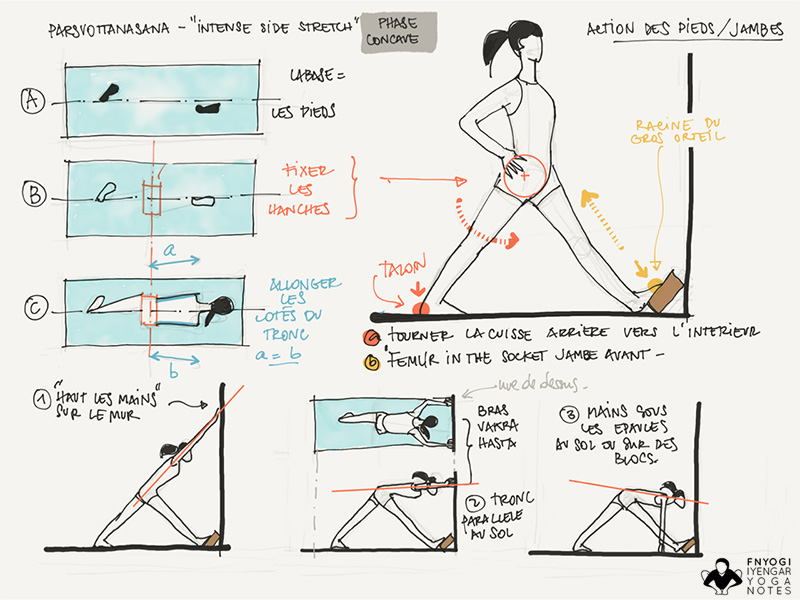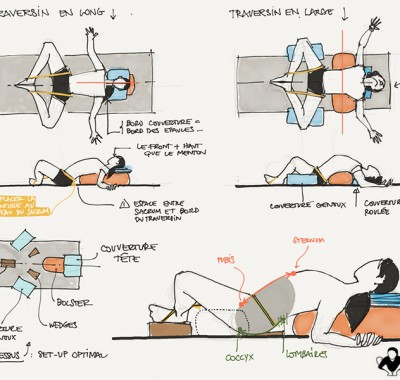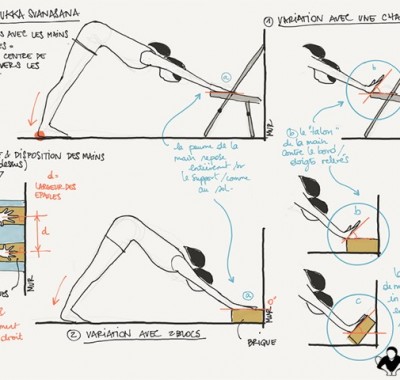Parsvottanasana is formed by the two words “Parsva” (sides) and “Uttanasana” (intense strechting), so it is a forward bending when the flanks are stretched intensely. According to B.K.S. Iyengar this posture would have a refreshing effect on the brain (“cools the brain and soothes the nerves”).
It is therefore a good omen in these times where spirits easily warm up.
For this article, I limited myself to three versions of the “concave” version (one must understand “where the back is straight”), and you will see why not the final posture. Here I propose to study a variation of the posture with the front foot raised on a block in front of a wall.
What do we want in Parsvottanasana?
a) A clear base: the feet (drawing A)
The inside of the heels is in line.
b) Fix the hips (drawing B)
The hips are in line with the front edge of the carpet. This makes it possible to obtain an equal length of the sides of the chest.
c) Extend the sides of the chest (drawing C)
This is the meaning of the word “Parsvottanasana” as explained above : when the feet and hips are fixed, then the upper body is projected towards the shinbone of the foreleg while extending the sides of the trunk “intensely” from the chin moving forward.
Why use a block?
In Parsvottanasana, as in standing poses where the trunk is turned forward (as for example Virabhadrasana 1), one seeks to have both sides of the hips in line with the edge of the mat (see drawing C). Now the correct alignment of the hips can not be obtained without a good base, ie without a good job of the feet. This is our driving action to get the rotation of the hips.
In this asana, it is often observed that students lose firm pressure of the inner front foot to the ground. Having the front foot supported allows to firmly press the root of the big toe in order to activate the inside of the front leg, reaching to the buttocks bone. This slightly shifts the center of gravity backwards, which helps squeezing the back heel in order to activate the back leg upwards.
Hands on the wall
Use of the wall is done once the base is fixed (feet and hips). The wall helps to stabilize in the posture, but not only: at first (drawing 1) the hands are raised as high as possible, this extends the sides of the chest even more, then the abdomen is brought parallel to the ground (drawing 2). The hands and elbows are placed on the wall at the same height as the shoulders while keeping the back straight and the sides of the chest well stretched. It is an intermediary step before touching the ground with the hands or on blocks placed below the shoulders. This is the concave version of Parsvottanasana.
Conclusion:
At this stage one could continue to describe the posture until its final stage where the chin, then the forehead comes to touch the shinbone. But in fact it is a continuation of the work described above : in order to reach the final posture, there is nothing else to do but what is described above, a great flexibility in the hamstrings is especially necessary and since this is a sweet dream for many of us (unless you cheat with legs not really straightened… follow my eyes), it is a posture that you will not practice much in a beginner class.
You can find Fanny also on her own blog Iyengar yoga notes – http://www.iyengaryoganotes.com



